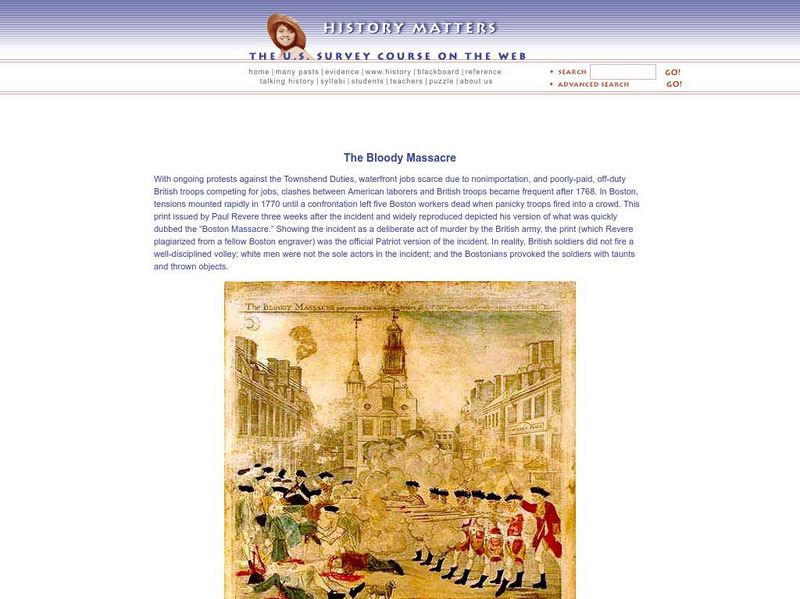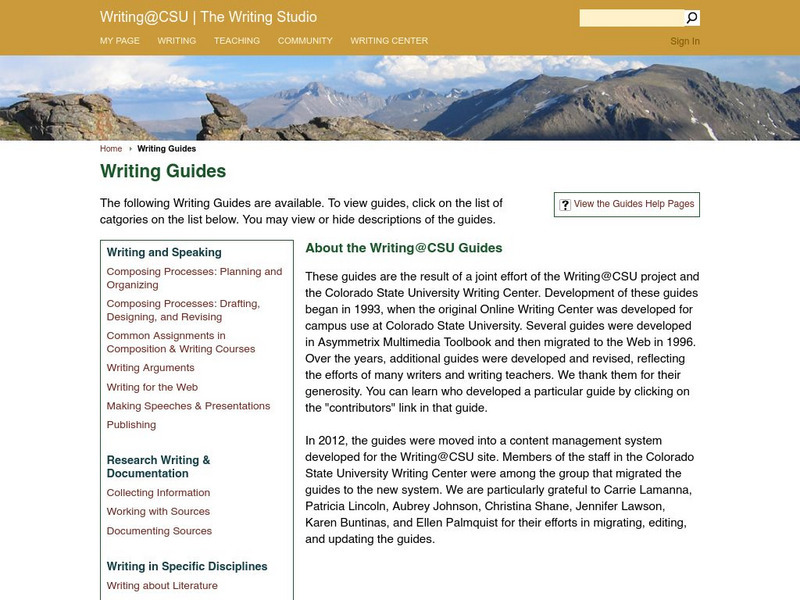Other
Plagiarism.org
A thorough site providing all writers with all the information they need to know about plagiarism. Understand what plagiarism is, types of it, methods to cite works, as well as other resources for educators, parents, and students....
University of Sydney (Australia)
The Write Site: Why & How to Use Sources
This University of Sydney reference explains the importance of using reputable sources in academic writings. Then the site provides steps to follow to assist students with using bibliographic sources. Click on the sections list to...
University of North Carolina
University of North Carolina Writing Center Handouts: Plagiarism
Use this handout to learn what plagiarism is and specific ways to avoid it. The explanation of "common knowledge" should be particularly useful to students. Although this handout is directed to college students, it is equally applicable...
Department of Defense
Do Dea: Discovery and Attribution
The research process can be daunting, but it doesn't have to be overwhelming! After you complete this self-guided unit, you will be well prepared to write a research paper. You will learn how to choose a topic, evaluate the reliability...
Other
Oslis: Research Process
Excellent site outlining each step for Internet research for grades 6-12. This site focuses on writing a research paper from selecting a topic through to the final paper. Click on Cite My Sources to get the electronic citation machines....
PBS
Pbs Learning Media: Decisions on Deadline
This collection contains two lesson plans and an interactive game that will facilitate discussion and deepen understanding of the complex issues raised in the documentary film, A Fragile Trust: Plagiarism, Power, and Jayson Blair at The...
PBS
Pbs Learning Media: Decisions on a Deadline Collection: "A Fragile Trust"
This collection contains two lesson plans and an interactive game that will facilitate discussion and deepen understanding of the complex issues raised in the documentary film, A Fragile Trust: Plagiarism, Power, and Jayson Blair at The...
REMC Association of Michigan
Remc Association of Michigan: 21 Things4 Students: 7. Be Legal and Fair
In this learning module, students will learn what they can do to make sure creative work remains under proper control. They will investigate copyright laws and whether there is a way to legitimately use the work done by others. After...
Common Sense Media
Common Sense Media: Digital Passport: Mix N Mash
Students remix media content to create a new creative piece. Along the way, they give proper credit to the artists whose images and sound clips they use. They learn about copyright, credit, and plagiarism and apply their knowledge to...
Curated OER
History Matters: The Bloody Massacre
Using Paul Revere's print, titled "The Bloody Massacre," as a gateway, this site explores the events of the Boston Massacre.
Towson University
Towson University: Online Writing Support: Plagiarism Information
This page offers links to information about plagiarism, how to prevent it, statistics, and consequences.
University of Sydney (Australia)
The Write Site: Acknowledging Sources
An explanation of plagiarism is included this learning module. Students will learn why it is important to cite all sources during a research
Other
Western Illinois University: Plagiarism and the Web
An essay on the challenge of plagiarism for teachers and the temptation for students, with helpful suggestions.
Other
University of Hong Kong: Identifying & Avoiding Plagiarism
This interactive exercise allows students to judge for themselves what is plagiarized and what is not. Could be used independently or as a class activity.
Other
Kings Canyon Unified School District: Copyright and Plagiarism [Pdf]
This lesson teaches second-grade students about the differences between copyright, plagiarism, cheating, and stealing and the importance of respecting guidelines around them.
ReadWriteThink
Read Write Think: The Statue of Anne
A short activity centered around "Copyright Awareness Week." A good resource for teachers who are looking for manageable ways to teach the ethics and laws concerning copyrighting and plagiarism.
ReadWriteThink
Read Write Think: Research Building Blocks: "Cite Those Sources!"
Contains plans for two lessons about the research process. Learners discuss plagiarism, practice paraphrasing, and cite sources. In addition to objectives and standards, these instructional plans contain links to sites used in the...
Online Writing Lab at Purdue University
Purdue University Owl: Quoting, Paraphrasing, and Summarizing
Provides guidance on the ways to quote, paraphrase, and summarize information. Gives various reasons for paraphrasing, summarizing, and quoting various sources.
ReadWriteThink
Read Write Think: Exploring Plagiarism, Copyright, and Paraphrasing
Contains plans for three lessons that deal with plagiarism, copyright law, and how to paraphrase correctly. In addition to objectives and standards, this instructional plan contains links to PDF handouts and sites used in the lessons as...
English Club
English Club: Plagiarism
This EnglishClub tutorial explains what plagiarism is, why students plagiarize assignments, and the serious repercussions of plagiarizing.
Colorado State University
Colorado State University: Writing @ Csu Writing Guides
This is a fairly sophisticated series of writing guides. It assumes that users already have a solid grasp of spelling, grammar and mechanics, so it focuses more on organization and types of presentation than on more basic skills....
Indiana University
Indiana University: Plagiarism: What It Is and How to Recognize and Avoid It
A guide for the student to understand what plagiarism is and how to avoid it in their work.
Lumen Learning
Lumen: Boundless Communications: Plagiarism
This lesson focuses on plagiarism including the different forms of plagiarism, avoiding plagiarism when using the Internet, don't copy and paste, and the likelihood of being caught.
Lumen Learning
Lumen: Boundless Communications: Variations in Language
This lesson focuses on the use of variation in language when preparing a speech including directness, subjectivity and objectivity, abstraction, and accurate, reliable, unbiased, credible, and current sources.




















